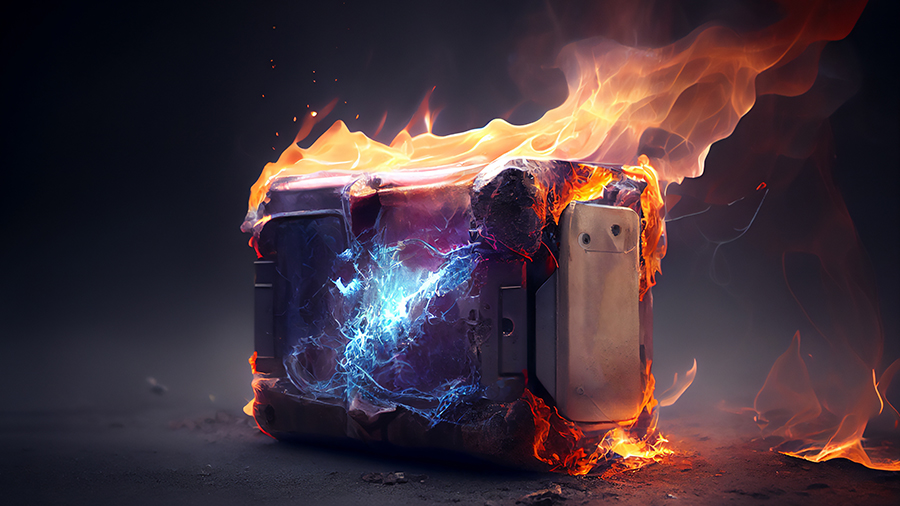Blog
May 23, 2023
Why Hybrid Supercapacitors are the Safest Choice for Energy Storage
By Carla Brown, Product Marketing Manager |

Unstoppable wildfires, toxic chemical leaks and chain-reaction fires that keep burning — threatening the safety of our surroundings and our well-being. Sounds surreal, like something straight out of a sci-fi movie, right?
Unfortunately, these events are all too real and increasing with alarming frequency as more Lithium-based batteries are being used for electric vehicles, communication devices and other applications. Just last year, the state of New York passed legislation to deal with the threat, describing fires caused by lithium-ion batteries as “extremely dangerous,” “self-sustaining” and “difficult to contain and extinguish.” Since 2021, eleven people in New York City alone have perished in fires related to lithium-ion batteries.
While the dangers posed by lithium-based energy storage devices used in stationary applications, including backup power for communications operations, are less threatening, cable operators and other broadband service providers should be aware of the safety risks associated with electrochemical-based standby power mediums.
Thermal Runaway
The danger is primarily due to a chemical event that can occur in electrochemical batteries (Lithium-based or valve regulated lead acid (VRLA) called thermal runaway, which happens when batteries overheat due to overuse or physical damage. Once thermal runaway spreads, or propagates, it is nearly impossible to control.
Thermal runaway can be triggered in Lithium-based batteries by abusive conditions that create intense heat — activated by either electrical or impactive mishaps. Internal cell failures leading to overheated conditions in Lithium-based batteries can be caused by an overcharge, over-discharge, short-circuit or extremely high or low temperatures. Once a Lithium-based battery moves into a thermal runaway condition, its self-heating state creates an extremely high temperature that leads to toxic off-gassing and fire that propagates to other cells and combustible materials.
Once thermal runaway spreads, or propagates, it is nearly impossible to control.
A group of cells can be destroyed within seconds due to this chain reaction. While improvements in cell design, cooling systems and safety control enhancements have decreased the danger of using lithium-based batteries, the risk of thermal runaway still exists.
Introducing Hybrid Supercapacitors
The good news is that recent technological advancements in energy storage are pushing the chances of battery-related mishaps to near zero. Hybrid supercapacitors, unlike lithium-based and lead-acid batteries, are electrostatic, meaning that energy is not produced by chemical reactions, essentially eliminating the source of thermal runaway.
ATX recently validated that claim by putting its Areca Hybrid Supercapacitor modules through a series of stringent abusive tests by an industry-leading lab. As illustrated in this video, Areca hybrid supercapacitors showed no sign of dangerous combustion or off-gassing — even after driving a large nail through a fully charged cell. The nail puncture produced only a light plume of smoke, but no thermal runaway or off-gassing.
Testing procedures also included overcharging, over-discharging, short-circuiting, hot and cold thermal shock as well as impact tests from one-meter floor drops and a forceful, weighted thrust. The ATX hybrid supercapacitor energy storage solutions passed all safety challenges.
Smart Start
Protecting the environment is now a priority for service providers around the world and based on the most recent HFC evolution survey from ATX, energy storage transformation is a high priority for eco-conscious broadband suppliers. The third-annual survey revealed that roughly 80 percent of participants identified modernizing lead-acid battery standby power operations as a priority in the coming year.
Communications operators can make a big ecological impact through technology choices that are safer for the environment and reduce carbon footprint. Maintenance-free Hybrid Supercapacitors are not only the safer choice but also significantly contribute to the reduction of carbon footprint by eliminating the need for annual site visits. The lifespans of hybrid supercapacitors are also as much as 5X longer than lead-acid batteries.
Broadband service providers looking for ways to transform their energy storage standby power operations should start by kicking the tires of solutions based on hybrid supercapacitor technology. It is the smart, and safe, thing to do.

